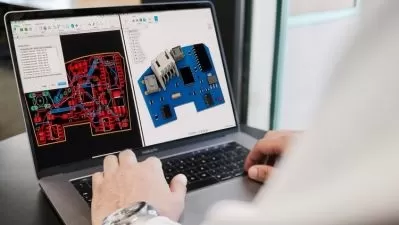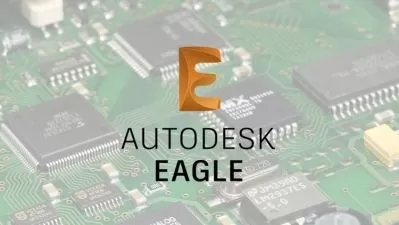Learn PCB Designing by making an MP3 Player!
Paresh K V
4:01:53
Description
A Beginner's Guide to the world of PCB Designing
What You'll Learn?
- Workflow of PCB Design
- Various Features of EasyEDA Software
- Build a cool MP3 Player
- Schematic and Layout Design Rules
- Gerber File Generation for Fabrication
- Footprint Verification
- Trace Width Calculation
- Different layers of a PCB (Silkscreen, Solder Mask, Paste Mask)
Who is this for?
More details
DescriptionLearn PCB Designing by building an MP3 Player from scratch. Right from making the reference circuits, testing them, designing the schematic and layout to finally enjoy the finished product!
Become skillful at designing PCBs with this Comprehensive Course
Learn about the EasyEDAÂ Software
Design a 2 layered PCB for an MP3 Player!
Grasp the various features provided by EasyEDA
Master the concepts pertinent to PCBs (Vias, Copper Pour, Trace width, Layer, etc.)
Generate Gerber Fabrication File and know what it comprises
Understand and Implement various features provided by the ESP32
Get Familiarized with the Design Rules for Schematics &Â Layout
Learn PCBÂ Designing to add another feather in your cap
This course is designed to explore all of these features with a very practical approach. If there is one goal of our course, it's to give you enough knowledge and confidence to go out there and build your own projects, which is the true essence of this course. This course is project based, so by the end of it, you’ll know how to make an really cool MP3 player with various features to change the song, volume, & pause play button.
Overview of the Course:
      This course is meant for people who want to get started with PCB Designing or those who want to convert their ideas into full fledged products. By taking this course, you'll be able to learn everything that one needs to know about designing PCBs and hence give you enough confidence to build projects on your own.
We start off with a brief introduction to EasyEDA, the software which will be used to design our PCBs. And then move on to the various rich features it provides us with. The primary reason for choosing EasyEDA is because
It is completely free
Short learning curve
Cloud Based Platform
Personally, I don’t like to learn anything if there is no proper end goal in mind. And that’s why I have specifically designed this course with a very practical approach. All the necessary information that a beginner needs to know about PCB designing are mentioned in this course. We discussed the workflow required for PCB designing: Ideation, Component selection, Testing and then using the software to design the Schematic and Layout of our PCB.
To keep things interesting, we've included quizzes and coding assignments as well. These are not too difficult that will make you tear your hair out, but just hard enough to pique your interests.
To make it easier for you to keep in track with the course, we have added external resources such as documentation, circuits &Â design files that have been used in the videos
Complete with working files and designs, you’ll be able to work alongside the instructor as you work through each concept, and will receive a verifiable certificate of completion upon finishing the course
Who this course is for:
- Makers/ Hobbyist interested in PCB Design
- Anyone who wants to convert their idea into a finished product
- Engineering Students looking for an opportunity to upskill
Learn PCB Designing by building an MP3 Player from scratch. Right from making the reference circuits, testing them, designing the schematic and layout to finally enjoy the finished product!
Become skillful at designing PCBs with this Comprehensive Course
Learn about the EasyEDAÂ Software
Design a 2 layered PCB for an MP3 Player!
Grasp the various features provided by EasyEDA
Master the concepts pertinent to PCBs (Vias, Copper Pour, Trace width, Layer, etc.)
Generate Gerber Fabrication File and know what it comprises
Understand and Implement various features provided by the ESP32
Get Familiarized with the Design Rules for Schematics &Â Layout
Learn PCBÂ Designing to add another feather in your cap
This course is designed to explore all of these features with a very practical approach. If there is one goal of our course, it's to give you enough knowledge and confidence to go out there and build your own projects, which is the true essence of this course. This course is project based, so by the end of it, you’ll know how to make an really cool MP3 player with various features to change the song, volume, & pause play button.
Overview of the Course:
      This course is meant for people who want to get started with PCB Designing or those who want to convert their ideas into full fledged products. By taking this course, you'll be able to learn everything that one needs to know about designing PCBs and hence give you enough confidence to build projects on your own.
We start off with a brief introduction to EasyEDA, the software which will be used to design our PCBs. And then move on to the various rich features it provides us with. The primary reason for choosing EasyEDA is because
It is completely free
Short learning curve
Cloud Based Platform
Personally, I don’t like to learn anything if there is no proper end goal in mind. And that’s why I have specifically designed this course with a very practical approach. All the necessary information that a beginner needs to know about PCB designing are mentioned in this course. We discussed the workflow required for PCB designing: Ideation, Component selection, Testing and then using the software to design the Schematic and Layout of our PCB.
To keep things interesting, we've included quizzes and coding assignments as well. These are not too difficult that will make you tear your hair out, but just hard enough to pique your interests.
To make it easier for you to keep in track with the course, we have added external resources such as documentation, circuits &Â design files that have been used in the videos
Complete with working files and designs, you’ll be able to work alongside the instructor as you work through each concept, and will receive a verifiable certificate of completion upon finishing the course
Who this course is for:
- Makers/ Hobbyist interested in PCB Design
- Anyone who wants to convert their idea into a finished product
- Engineering Students looking for an opportunity to upskill
User Reviews
Rating
Paresh K V
Instructor's Courses
Udemy
View courses Udemy- language english
- Training sessions 35
- duration 4:01:53
- Release Date 2022/12/24










